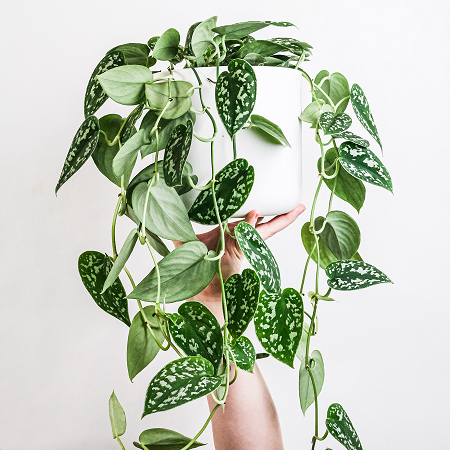
Welcome (nearly), Spring. We’ve been looking forward to your longer days and warmer rays. And just as we start to emerge from the winter, so too do our plants.
Spring is the time when plants are waking after their winter dormancy, and it’s the perfect time to schedule some support and care as we move toward the growing season. We’ve popped together a few tips for you to consider as you shift up your plant care routine; these simple steps will really make a difference for the growth ahead, and bring lots of lush for you to love!
OBSERVE AND ASSESS
The change of season is the perfect time to assess how your plants are developing - their overall form, balance and health. As plants have slowed during winter, some of their leaves may have wilted, and some older growth died back. Now is a good time to trim as part of your seasonal maintenance - many plants respond well to light prune as this encourages new growth in the next cycle.
Remove wilted and discoloured leaves and trim any leggy growth, to fashion a plant that is well balanced and allows good airflow, especially for those plants with heavier or dense foliage. Use snips that are sharp and have been cleaned/sanitised, to ensure the plant isn’t damaged in the process. Should there be any small new growth buds forming, steer clear of these - your plant has already woken up (hello, friend!). If you are caring for flowering plants, remove all spent flowerheads too (deadheading).
Some indoor plant cuttings can be propagated easily to create a new plant for yourself or for a gift; the pothos, for example, can be trimmed below a node and popped in water to root, taking about 2-4 weeks, then replanted in potting mix. Chat to your nursery or local plant store about the plant types you have at home, and give it a try. All other plant matter can be popped in the compost or green bin to cycle back into the system. (Caveat here - if you notice any diseased parts of your plant, these are best kept out of a cool compost.)

SOIL HEALTH (AND DOES YOUR PLANT NEED RE-POTTING?)
‘Re-potting and potting up is the classic indoor plant care step that’s tempting to skip, but your plants will thank you.’ (pistilsnursery.com)
Soil nutrients deplete over time, and during winter, plant growth has substantially slowed. And so, as your plants are getting ready to extend again, it’s time to boost nutrients and consider if your plants need re-potting - a trim of the roots, refreshed potting mix and replanted in their pot; this is great if you're happy with the size of the plant as it is, and is a good spring clean measure.
Plants can get pot-bound over time, meaning that their roots are very condensed and seeking additional space to grow. You may see roots coming out of the drainage holes in your planter, or notice that water moves quickly through the soil. If your plant requires a little extra space for growth, potting up to the next size pot is best done in this period. Increase the pot size by only an inch or so in diameter at any one time - this means the roots can access the water in the soil more easily as it's within root reach.
WATERING
As days become warmer, you’ll gradually need to increase the water for your plants. This will vary depending on the type of plants you care for – tropical plants will need more than your succulents or cacti. It's good to start slowly, and check soil moisture in each pot before adding more water. You can feel the soil moisture with your fingertip - if it's dry about an inch or so down, time for some more water.
Our friends at Plant Runner shared a great watering hack recently on their feed @plantrunnertruck: re-use the water that’s left over from cooking your pasta, potatoes and boiled eggs for your indoor plants.
‘The reason this is so good for your plants is that the starch left in the water is lapped up by plants, and the leftover nutrients are absorbed by the plants.’
Importantly, when re-using your cooking water this way:
1. let the water cool down to room temp overnight so they can drink it up in comfort the next day, and
2. leave the salt out of the cooking water - 'if you’re happy to forego a little seasoning for the sake of your plant fam, your plants will be all the happier for it.’
Catching rainwater to use on your plants is another good habit to get into, especially as we head into spring|summer. Good for your plants, good for the environment, happiness all round.

LIGHT LEVELS
You may have placed your plants in a different position during winter, to take advantage of the best lighting conditions at home, when the position of the sun varies and deciduous trees have dropped their leaves, allowing more light through some of your windows. Increased light is one of the indicators for plants that the season is changing. It's also one of the most important factors for photosynthesis, the creation of nutrients from sunlight and water.
Consider the conditions best suited to your plants and re-locate accordingly - it's a fun part of your overall spring clean, as you re-decorate with your plant babes. Plants will also naturally reach toward their light source; rotate your plants regularly to ensure an even spread. As light increases, so too does the heat that’s coming through your windows, so keep this in mind to avoid scorched leaves on those hotter days.
NUTRIENTS
Indoor plants only need fertiliser when they are actively growing, so the general rule of thumb for the annual fertiliser application is to apply in early spring when the weather is warmer and more light streams through your windows. If you're spotting a few new leaves and buds, that's your cue to start your plants on a feeding schedule to help support growth. We have both Munash Organics and The Plant Runner in store if you're thinking it's time for a boost. One note - if you've re-potted with new potting mix, this has nutrients already included, so tread lightly here and wait a little while until it settles in.
We have dedicated a full blog to our top tips for fertilising indoor plants for spring, to help you understand when, how and why you should fertilise your indoor plants to encourage lush, leafy growth. You can find the full blog here.
Enjoy the cycle of growth and change; we know you'll be smiling with the joy that this new season can bring. Pop past any time to ask us questions or to think about new options as you continue to build your plant world.
